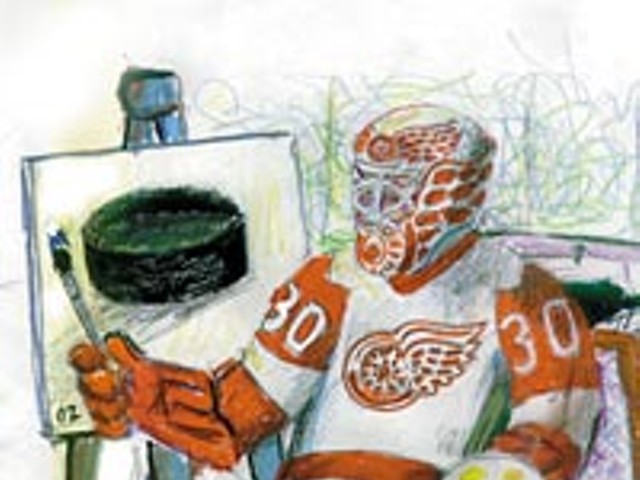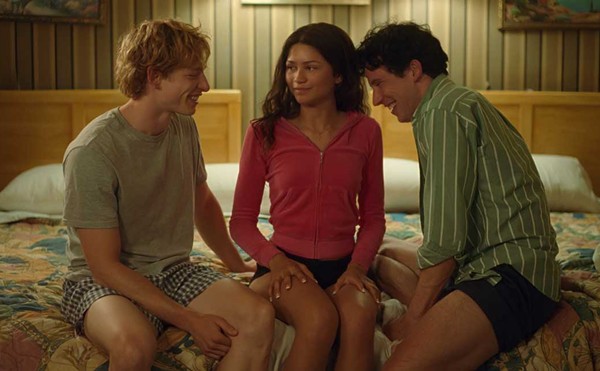The art event of the decade in these parts is the Detroit Institute of Arts exhibition Van Gogh Face to Face, featuring 67 paintings and drawings, all portraits, by the larger-than-life artist whose name is an international household word. George S. Keyes, curator of European paintings at the DIA, brought together these works from private collections and museums in Europe, Russia and the United States, and attendance for the resulting show – which will travel to both Boston and Philadelphia – threatens to overwhelm the museum’s ability to contain it. With the show’s closing date just over a month away, MT art writers Liz DiDonna and George Tysh made their way through the throngs one afternoon for a look at the artist whose Portrait of Dr. Gachet (not in the present show) was bought by a Japanese industrialist for $82.5 million in 1990, the highest price ever paid for a single work of art.
George Tysh: There are so many people in here! I hate it when you can’t see anything but the back of somebody’s head in these blockbusters.
Liz DiDonna: I know – I feel so claustrophobic and I think some guy just pinched me.
Tysh: Hey, just check out the masterworks. I’ve heard the drawings are the strength of the show. In fact, they fulfill one idea of what fine draftsmanship should be – perfect renderings, perspective, volume, light and shadow.
DiDonna: Van Gogh considered his drawings to be studies, not really finished works like his paintings. The drawings have a fluid consistency – they feel impassioned by the stroke of his hand.
Tysh: It’s the kind of realistic work that convinces anybody of his greatness. When an artist renders ordinary life so vividly, you don’t get too many arguments about his importance, not like you would if this were a Jackson Pollock or Ellsworth Kelly exhibition. But then, you wouldn’t have these insane crowds lining up for action painting or color field work.
DiDonna: Van Gogh has certainly reached celebrity status with people today. If you asked anyone on the street to name a famous artist, whether they were interested in art or not, it would be either van Gogh, Picasso or Warhol. And everyone can identify a van Gogh self-portrait. Especially now since he’s on every bus and taxi cab in town.
Tysh: Our mythology about him is that he was destitute, nutty, unmanageable, sort of the ultimate loser in yuppie terms – an artist who never sold a painting while alive, but whose work has been the most expensive stuff on the market for decades. We admire him to the point of hysteria, yet who of us would have wanted to know the guy, to hang out with him or even pose for one of these portraits?
DiDonna: I think that persona isn’t completely accurate. When you read some of his letters to his brother Theo, they’re poetic and filled with sensitivity and integrity. He was probably the most human guy around, surrounded by a bunch of hypocrites. And I think people get off on the fact that he’s a tragic figure, that he was a total failure, financially speaking. But what does it matter, anyway? It seems as though you can’t look at a van Gogh without adding his mythos to it. The paintings might as well have a halo of light surrounding them or a logo in their lower right-hand corners – they contain a sort of significance that’s both holy and commercial.
Tysh: The curators have hung up quotations from van Gogh’s letters and such, some of course sounding prophetic, like this one: "I should like to do portraits which will appear as revelations to people in a hundred years’ time." You bet. Or this other one: "What is required in art nowadays is something very much alive, very strong in color, very much intensified." Which works not only with his own output, but pretty much applies to the impressionists in general.
DiDonna: And how about the placement of those quotes? The DIA hasn’t hung them at eye level – they’re way up over the archways, as if we’re looking up towards heaven for divine wisdom.
Tysh: Hey, I don’t mind a little adulation (or even a lot) for the genius crew – Rembrandt, Velasquez, Matisse et al. – but things do get a bit shrill for old Vincent, right up there with Elvis and Marilyn. And how many folks have been turned off by the $16 ticket price, $18 on weekends? Here’s a relatively small exhibition of arguably the world’s most famous artist, and it costs as much as a meal. It’s like one of those exclusive gourmet restaurants – the higher the price, the smaller the portions. But does anybody mind?
DiDonna: Certainly not people who can afford the ticket price, but what if that’s not within your means? A family of four can visit the whole DIA for $16 anytime. But how many of these van Gogh fans come here regularly?
Tysh: This is going to be the most popular show in the museum’s history, even more than The Splendors of Ancient Egypt in 1997. It’s certainly great for attendance and PR, but there are a couple of paintings here that raise some interesting questions. For instance, Skull (1887-88) isn’t discussed on the Acoustiguide and gets just a few lines in the catalogue. What’s it doing in the show? The skull has traditionally been interpreted as a still-life memento mori, not a portrait, and in the middle of all this high-priced celebration, it’s like a sign of unconscious dread – like the mysterious guest in Poe’s "The Masque of the Red Death." Or how about The Mudlark (1888), a portrait of a girl like something right out of 20th century German expressionism, with its strange drawing and color? Though they seem out of place here, these pieces make van Gogh even more of a visionary than we give him credit for.
DiDonna: Check out this quote: "I am often rich ... not in money, but ... because I have found in my work something which I can devote myself to heart and soul, and which inspires me and gives a meaning to life." It seems that he was in touch with his life’s work so much that nothing else really mattered. It’s a far cry from our frantic money worries in America today.
Tysh: Speaking of which, what is the deal with the show’s exit feeding right into the biggest gift shop you’ve ever seen? Is this too obvious or what? Two brightly lit rooms crammed with the most hideous stuff you can (or couldn’t even) imagine: van Gogh refrigerator magnets, van Gogh mouse pads, van Gogh screen savers ("flowers and blossoms"), a board game called Vincent Time Path ("Play, Have Fun and Walk the Path of Vincent"), a sunflower pen, van Gogh boxer shorts, backpacks, coffee mugs, a van Gogh CD titled Van Gogh Face to Face: A Musical Palette (tunes by Debussy, Berlioz, Liszt and more – whaa?!), little plastic tables with van Gogh paintings in their tops, neckties, earrings, caps, tote bags, and on and on. Of course any show will have a catalogue, a poster, postcards, books, even stationery for sale, but this is one obscene orgy of marketing.
DiDonna: But can you blame the DIA for it? They’re giving the public what it wants and sales will generate much-needed funds for the museum. It’s incredible how enthusiastic people get about buying things that confirm their experiences. Yesterday it was a baseball pennant and today it’s a "Vincent" T-shirt.
Tysh: The shop should dress up some ladies like Potato Eaters, in basic, funky black, but with short tutus and high heels – call them the van Gogh-Gogh girls – and have them sell "Sunflower" cigarettes, "Vincent" candy bars and absinthe martinis.
George Tysh is Metro Times arts editor. E-mail him at [email protected]




